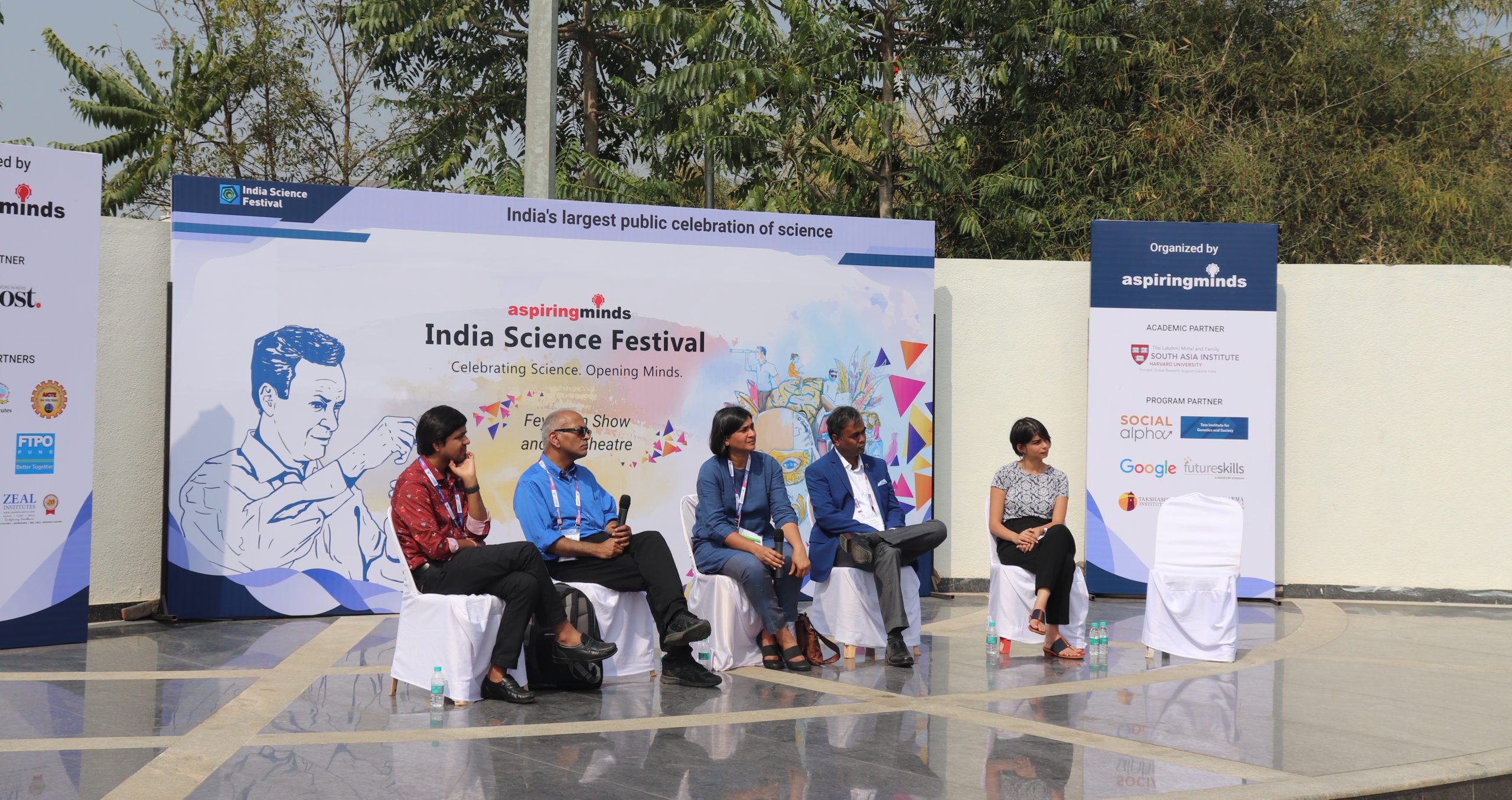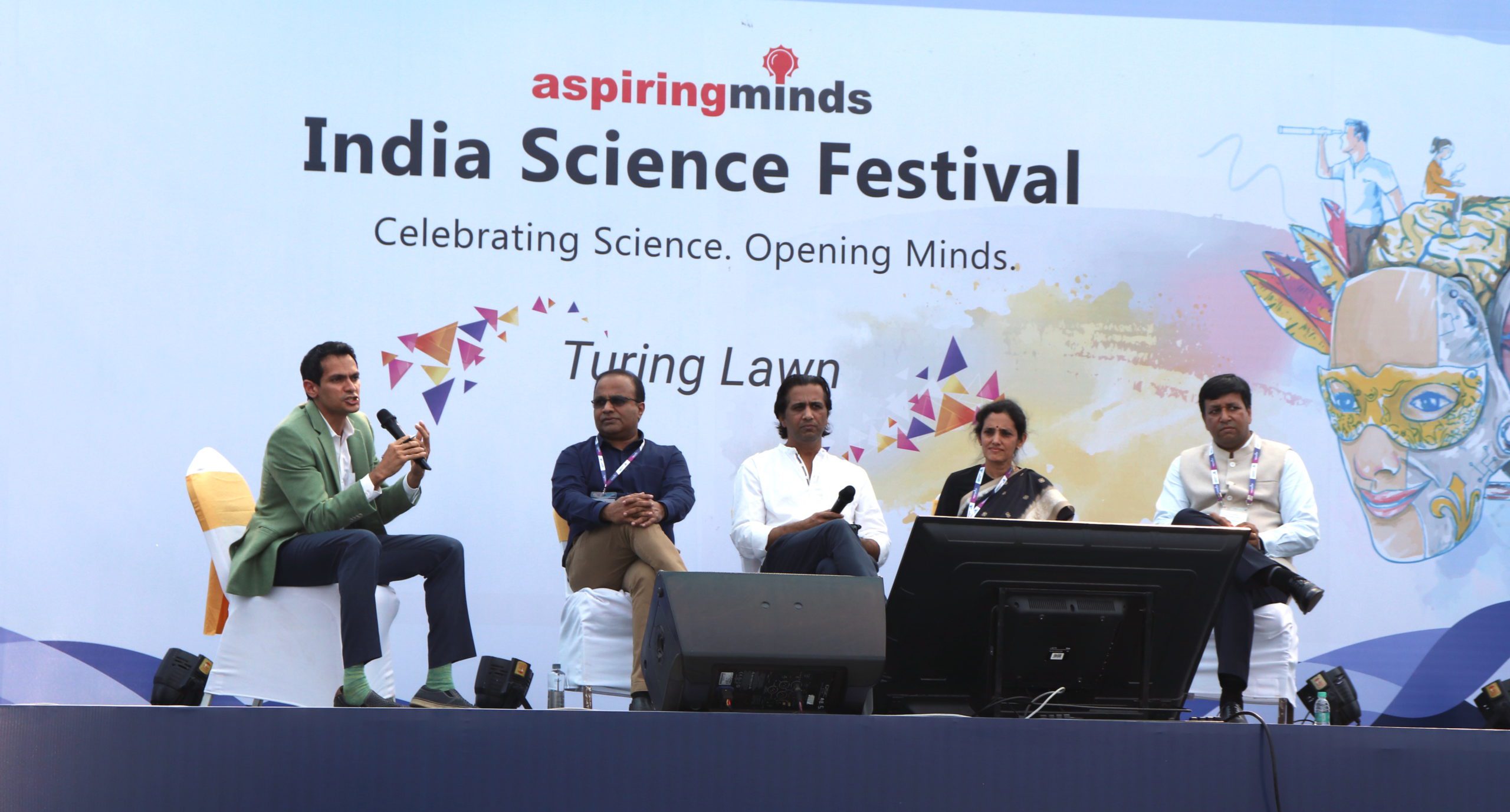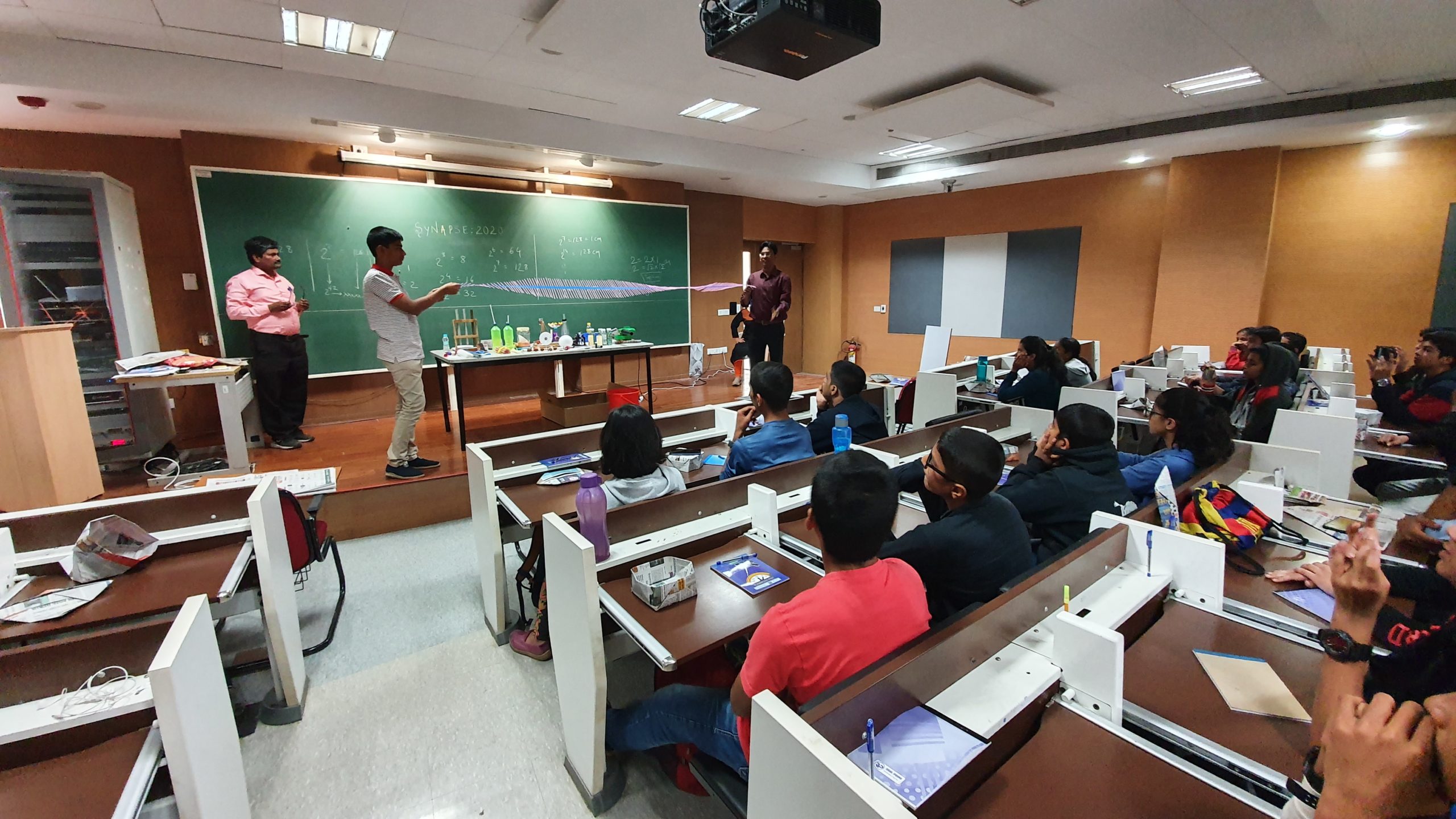
Panelists at the India Science Fest take audience questions.
The beginning of 2020 marked a massive celebration of science with the India Science Fest (ISF) in Pune, India, which aimed to bridge the gap between scientists and society and help the youth engage with the latest in science and technology from across the world. The festival, organized by Aspiring Minds and the Mittal Institute, brought the international science community to the Indian Institute of Science Education and Research (IISER). Social Alpha, the Tata Institute of Genetics and Society, and Google AI Research were key supporters of the festival.
This year’s major themes were Artificial Intelligence and Neuroscience, with additional focus on life sciences, astronomy, and quantum physics. Through talks, panel discussions, exhibitions, and experiments, participants learned about the history of science, women in science, science and the arts, and India’s place in the world of science. Several hands-on demonstrations at the festival included AI-generated art, autonomous vehicles, and brain-controlled helicopters. The gathering of top scientists under one roof resulted in a variety of policy discussions, helping to make connections for future collaborations. With several thousand attendees — particularly students — travelling from different parts of India, it’s clear that an interest in science throughout the country is growing.
Prioritizing Science — and Making it Accessible to All
An evening keynote panel delved into whether or not science should be a priority for India. Payal Arora (Erasmus School of Philosophy) emphasized the importance of quality science and if, in our scientific pursuits, we are asking the right questions. As a digital anthropologist, Arora pointed to the bias evident in scientific research catering to a small group of people — often males. Arora also spoke of the merits of crowdsourcing data to make it easier to identify the marginalized minorities and improve inclusivity in science. Finally, she spoke of “citizen science” or the “popularization of science” in the era of fake news, and how this could reduce science to mere opinion on the internet. As the next generation of users go online, she said, the biggest challenge seems to be that the algorithmic force can shift the fake before the truth.
Venkatesh Murthy (Harvard University) kicked off the second day of the festival. He began by asking if science, like music, could be treated like a hobby. He elaborated, explaining the importance of events like the India Science Fest, and emphasized how making science inexpensive is fundamental for its democratization.
How Can Algorithms, Data, and Genomics Impact Society?
Milind Tambe (Director, AI for Social Good at Google Research India) gave an overview of the various stages of work that his research center undertakes in the areas of education, agriculture, and healthcare. He spoke of the importance of immersion exercises with interdisciplinary partners (such as governmental and non-governmental organizations already working on the ground) to develop an understanding of the type of data to collect. Next, they rely on a prescriptive algorithm to ascertain which high-risk cases they should intervene in. After deploying the algorithm as part of field testing, they uncover the weaknesses of the algorithm — critical in learning how to effectively collect data.
In a session on genetic engineering, Suresh Subramani (Tata Institute for Genetics and Society), discussed how immunizing mosquitoes could mitigate the high incidence of malaria and dengue in India. This, he said, was possible through new gene-editing technologies for “population replacement,” which allow scientists to engineer mosquitoes by cutting the DNA at a particular point using molecular scissors, making them incapable of transmitting malaria parasites. When the engineered mosquitoes — immune to malarial parasites — mate with other mosquitoes, their progeny will receive the edited genes, replacing the population that could cause malaria with a population that cannot cause malaria. Subramani pointed out that a careful assessment of the risks and how to manage them is required, asking the audience: “Should we shoot the world’s deadliest messengers, or disarm them through genetic engineering?”
Raja Mugasimangalam (Genotypic Technology) discussed genomics as an enabling tool in market economy, as it generates a lot of data. His company manufactures DNA sequencers that could be used to map genomes or compare genomes across multiple samples — which manufacturers can then use to influence consumer patterns.

Satchit Balsari, Harvard University, moderates a plenary session with a panel of scientists.
Influencing the Future of Healthcare
Does the excitement about technology translate to the public sector? Sunita Nadhamuni (Head, Healthcare Solutions, Dell Technologies) delved into that question, discussing how India is currently experiencing an epidemiological transition — shifting from a prevalence of communicable diseases (such as cholera, tuberculosis, and malaria) to hypertension and cancer. The poor are disproportionately impacted by these diseases, as they are less likely to get routine tests done or make follow-up appointments.
In a plenary panel organized by the Mittal Institute, Satchit Balsari discussed how accredited social health activists (ASHA workers) have changed the way primary healthcare is delivered in India. These community health workers make door-to-door visits and are familiar with the communities in which they live and operate, and thus have proven to be effective at enrolling citizens in government healthcare programs while overseeing its implementation through follow-up visits to the same households.
Under Ayushman Bharat (National Health Protection Scheme), Dell Technologies is attempting to screen every single individual over the age of 30 for five common diseases. To do this, community healthcare workers visit households and remind people that they need to be annually screened for diabetes through blood pressure and glucose testing and every five years for cancer. More than a million ASHA workers and half a million nurses carry out this ambitious task — each nurse looking after 5,000 individuals. These workers, armed with tablets, receive reminders and schedule appointments, making technology a real game-changer in allowing programs to realize their full potential. Once this massive data is collated, much more becomes possible, such as diagnosing diabetic retinopathy and performing breast cancer imaging. With data from 500 million people, there is real potential to influence clinical medicine and scientific discovery.
Keeping in theme, Pawan Sinha (MIT) touched on the beautiful complementarity of the humanitarian and scientific aspects of research and outreach done by his organization, Project Prakash. Named after the Sanskrit word for light, Project Prakash provides surgeries to curably blind children in India, and its team observes them during recovery to track the development of vision in the brain. As part of its outreach, the healthcare workers engaged with Project Prakash travel to remote villages that have limited access to healthcare to screen blind children and, if they are eligible, enroll them in the program.
Santanu Bhattacharya (Chief Data Scientist, Airtel) spoke of the data collection his group performs and its potential to influence healthcare. His group collects about half a trillion records of data sessions per day, out of 300 million users. This data can analyze if the users had been hyperactive in the past three years, and can detect variance in their moods, further hinting at depression or anxiety.

High school students learn about wave motion at a weekend science camp during India Science Fest.
Spotlight: “Synapse” Student Workshop
During the festival, a small, closed science and technology camp called “Synapse” was organized for students from the 8th to 11th grades. Its aim was to provide students with an opportunity to interact with scientists at all stages of their careers, helping the students see the world of science up close. The students participated in several hands-on activities and programs that are working to lower the barrier of entry to scientific fields.
This camp was organized in collaboration with Atal Innovation Mission. Seven different schools throughout Pune, in partnership with Atal Tinkering Labs, nominated a total of 46 curious and enthusiastic students. These students spent the weekend at IISER, interacting with scientists from different fields. Lajja Patel, an MBBS student at AIIMS Delhi, and Ankur Goel, a former Research Fellow at Harvard Biodesign Lab, helped curate the programs in the science camp for the students.
Patel gave students a lesson on organ donation, describing how organs are kept and maintained in medical schools and laboratories. Students learned about the structure of the brain and spinal cord by observing a real brain that Patel brought for demo. Following that, Vivek Jayaram gave a talk, titled “A Day in the Life of a Neuroscientist,” in which he explained his research to the students.
Goel introduced the students to the world of soft robotics, and Harshit Aggarwal, a researcher from Adobe, gave demos of art created using Artificial Intelligence. Nixon Abraham, Assistant Professor at IISER, closed the day by displaying his team’s experiments with rodents, and describing how they can be taught basic decision-making.
On the second day, Ashok Rupner and his team from Science Activity Center brought the world of science straight to the students’ hands in the form of readily available, daily-use materials. They saw wave motion displayed through straws and tape, and made a generator using wires and magnets. Suresh Subramani, a Professor at UCSD, shared his life experiences with the young students, and giving tips on how to succeed in science. To close out the camp, Jithin — founder of CSpark Research — demoed a few physics experiments with handheld devices that the students could play with.
———————————————————
Read about India Science Fest in the media!
- India Science Festival 2020 in Pune will use AI to bridge gap between scientists and society, Hindustan Times
- Driverless car to mutant fly: IISER Science fest brings innovating science experiments to Pune, Hindustan Times
- Pune: Science fest at IISER focuses on AI, neuroscience, life sciences, Indian Express
- India Science Festival 2020 promises AI-art, levitating objects with your brain, interactions with international scientists, First Post
